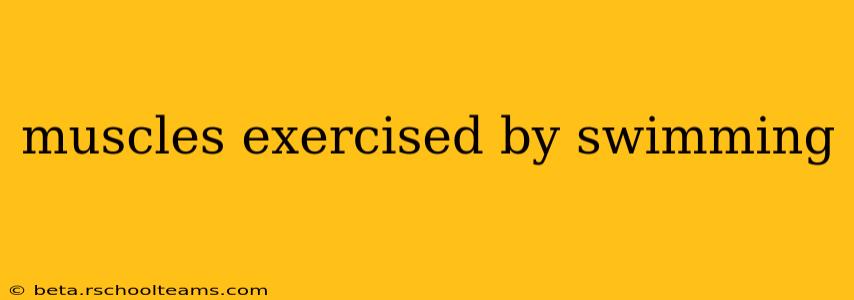Swimming is a fantastic full-body workout, engaging numerous muscle groups simultaneously. Unlike many exercises that isolate specific muscles, swimming provides a dynamic, fluid movement that strengthens and conditions your entire physique. This comprehensive guide delves into the specific muscles targeted during different swimming strokes, highlighting the benefits of this versatile exercise.
Major Muscle Groups Engaged in Swimming
Swimming is a remarkably efficient way to build strength and endurance. The constant resistance of the water works your muscles intensely, leading to significant improvements in both muscular strength and cardiovascular health. Here are some of the primary muscle groups involved:
Upper Body Muscles:
-
Shoulders: The shoulders are heavily engaged in all strokes, particularly the freestyle and backstroke. The deltoids (anterior, medial, and posterior) work together to propel you through the water. Swimming strengthens and defines the shoulders, contributing to improved posture and upper body strength.
-
Chest: The pectoralis major and minor muscles are crucial for pulling your arms through the water. The powerful strokes of breaststroke and butterfly particularly target these chest muscles, leading to increased muscle mass and definition.
-
Back: The latissimus dorsi (lats), trapezius, and rhomboids are essential for powerful pulls and maintaining proper body alignment. Backstroke, in particular, heavily emphasizes these back muscles, contributing to improved posture and strength.
-
Triceps and Biceps: These muscles work in coordination during the propulsion phase of each stroke. The triceps are primarily involved in extending the arm, while the biceps are involved in pulling. Swimming provides a balanced workout for both, improving overall arm strength and definition.
-
Forearms: The forearms, including the flexor and extensor muscles, play a critical role in maintaining grip and power during the pull phase. They often experience significant strengthening and definition from regular swimming.
Core Muscles:
-
Abdominals: The rectus abdominis, obliques, and transverse abdominis are crucial for maintaining core stability and generating power. A strong core is essential for efficient swimming technique and injury prevention. Swimming engages these muscles throughout each stroke, leading to a strengthened core and improved posture.
-
Lower Back: The erector spinae muscles in your lower back work in conjunction with your core muscles to maintain balance and generate power. Swimming strengthens these muscles, helping to prevent lower back pain and injuries.
Lower Body Muscles:
-
Legs: While not as intensely engaged as the upper body, the legs play a vital role in maintaining body position and generating propulsion, particularly in the kick. The quadriceps, hamstrings, and gluteal muscles all contribute to the powerful leg movements, improving overall lower body strength and endurance.
-
Calves: The gastrocnemius and soleus muscles are essential for the powerful kicks used in many strokes. Swimming provides a great workout for these calf muscles, improving strength and endurance.
Benefits of Swimming for Muscle Development
Beyond the sheer number of muscles engaged, swimming offers several unique benefits for muscle development:
-
Full-Body Workout: Swimming’s dynamic nature works the entire body simultaneously, promoting balanced muscle development.
-
Low-Impact Exercise: The buoyancy of the water reduces stress on joints, making it ideal for individuals with joint pain or injuries.
-
Improved Cardiovascular Health: Swimming is an excellent cardiovascular workout, improving heart health and endurance.
-
Increased Flexibility and Range of Motion: The fluid movements of swimming improve joint flexibility and range of motion.
Conclusion: Dive into a Stronger You
Swimming provides a comprehensive and effective full-body workout. The constant resistance of the water, coupled with the dynamic movements of different strokes, results in significant gains in muscle strength, endurance, and overall fitness. So, dive in and discover the transformative power of swimming for your muscular development!
